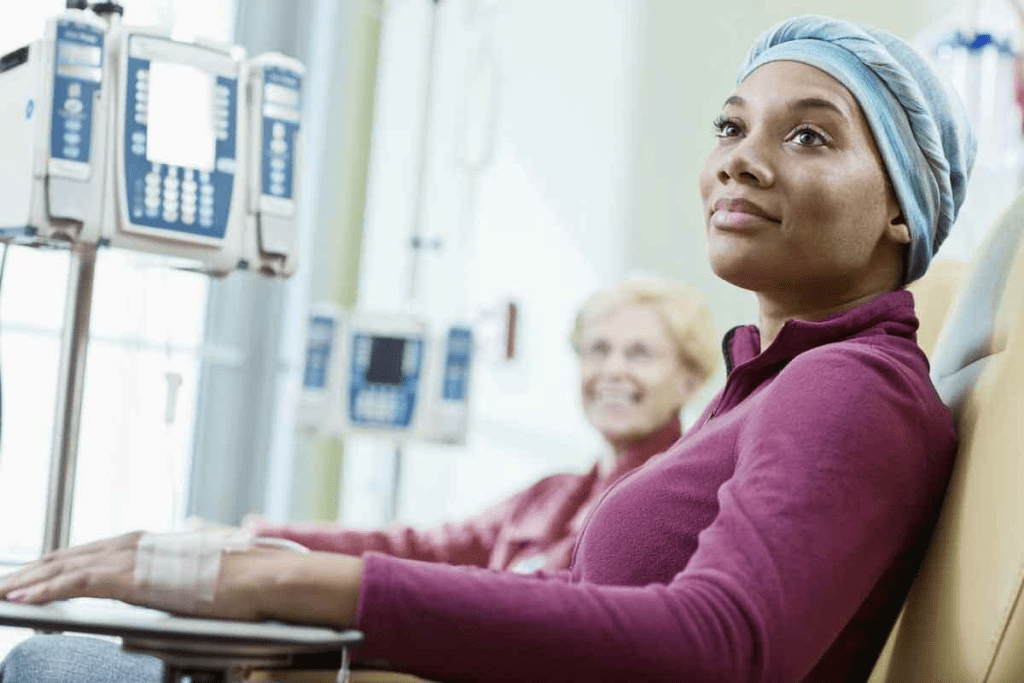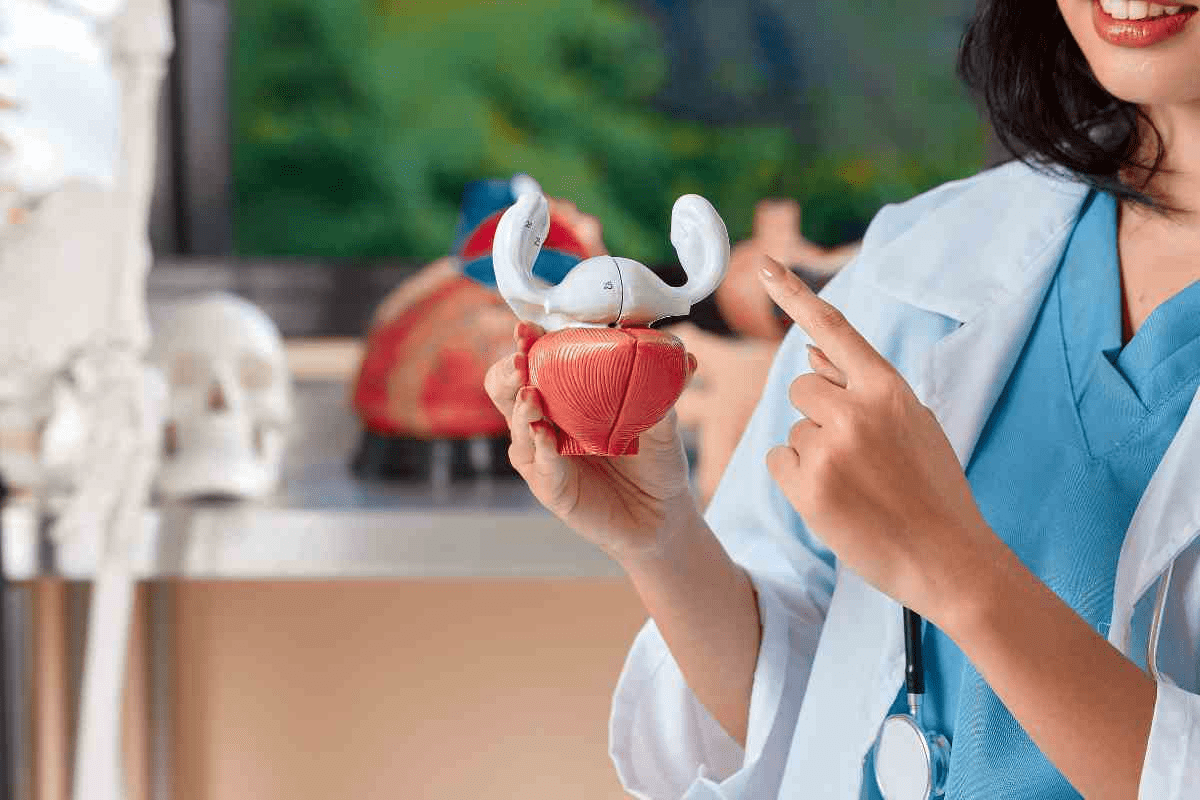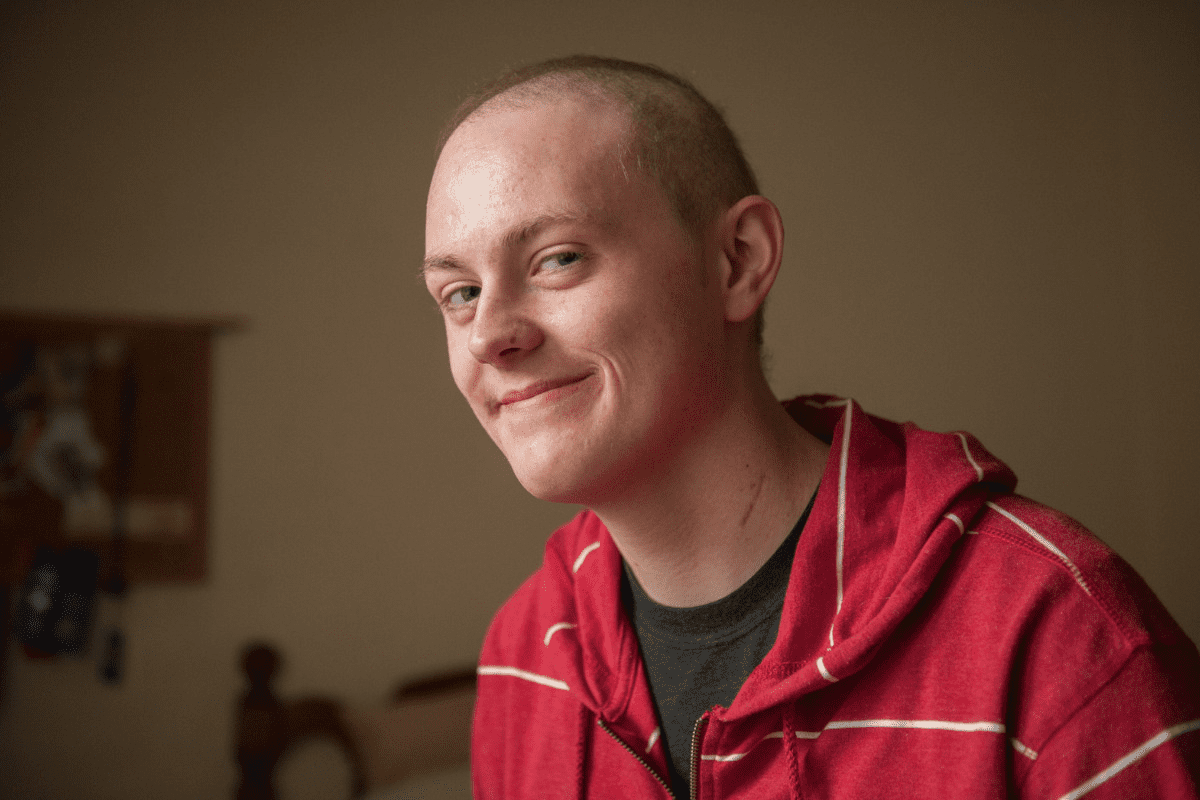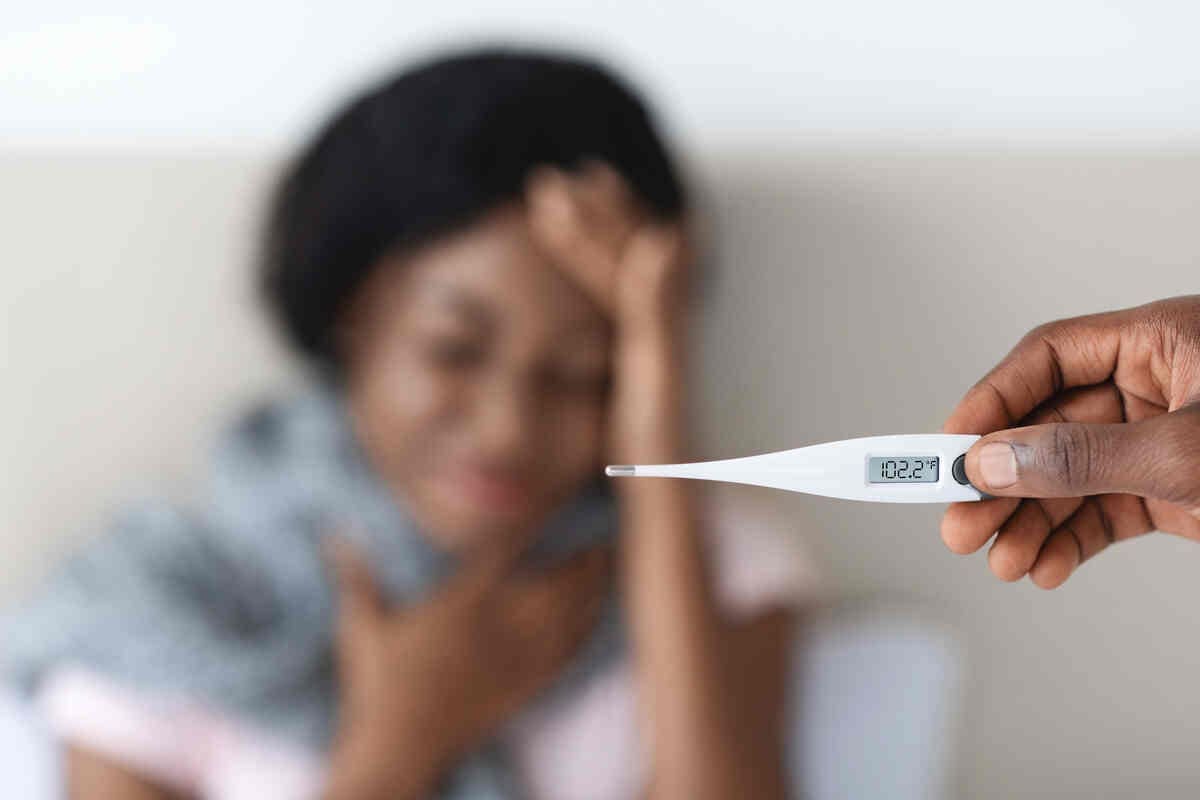Last Updated on November 27, 2025 by Bilal Hasdemir

Chemotherapy, also known as ‘quimio,’ is a key cancer treatment. It uses drugs to kill cancer cells by stopping them from growing and dividing. At Liv Hospital, we know how vital chemotherapy is in fighting cancer.
Chemotherapy can help cure cancer, slow its spread, or ease symptoms. There are many types of chemotherapy, each working differently. They are chosen based on the type of cancer, making chemotherapy a flexible treatment.
Learning about chemotherapy and its uses helps patients make better choices about their care. At Liv Hospital, our team’s trusted knowledge and high standards give patients confidence in chemotherapy cancer treatments.
Key Takeaways
- Chemotherapy is a cancer treatment that uses medicines to destroy cancer cells.
- It can be used to cure cancer, control its spread, or relieve symptoms.
- Different types of chemotherapy are used for different types of cancer.
- Chemotherapy can be used alone or with other cancer treatments.
- Liv Hospital provides trusted expertise and international standards in chemotherapy and cancer treatments.
Understanding Chemotherapy: What Is Chemotherapy and What Does It Do

Chemotherapy is key in fighting cancer. It uses drugs to kill cancer cells all over the body. This treatment is also known as “quimio.”
Definition and Basic Principles of Chemotherapy
Chemotherapy uses chemicals to fight cancer. It stops cancer cells from growing and dividing, causing them to die. The National Cancer Institute says it can be used alone or with other treatments like surgery and radiation.
Chemotherapy works because it targets cancer cells’ fast growth. Normal cells grow more slowly, so they’re less affected by the drugs.
The History and Evolution of “Quimio” as a Cancer Treatment
Chemotherapy started in the early 1900s. Back then, people noticed chemicals could slow cancer cell growth. Today, thanks to new drugs and methods, chemotherapy is more precise and effective.
How Chemotherapy Differs from Other Cancer Treatments
Chemotherapy is different from surgery and radiation. It goes through the blood to reach cancer cells everywhere. This makes it great for treating cancers that have spread.
Surgery and radiation focus on one area. Chemotherapy can boost their power when used together.
“Chemotherapy is a critical component of cancer treatment, targeting cancer cells all over the body.”
Expert Opinion
Knowing how chemotherapy works helps patients understand their treatment options. It lets them make better choices for their care.
The Science Behind How Chemotherapy Works
Chemotherapy is a key cancer treatment. It works by stopping cancer cells from growing and dividing. This is because cancer cells grow fast.
Targeting and Killing Cancer Cells
Chemotherapy drugs stop the cell cycle. This is how cells grow, divide, and multiply. Cancer cells, which grow fast, are hit hard by these drugs.
The cell cycle has different phases. Chemotherapy targets cells in these phases. This helps reduce cancer cells in the body.
Types of Chemotherapy Drugs and Their Mechanisms
There are many types of chemotherapy drugs. Each works in its own way. Here are a few:
- Alkylating agents, which damage DNA, stop cancer cells from making more.
- Antimetabolites, which block DNA and RNA production, are needed for cell division.
- Anthracyclines, which get in between DNA strands, stopping DNA and RNA making.
- Plant alkaloids, which stop cell division, keep cancer cells from growing.
These drugs can be used alone or together. The choice depends on the cancer type and stage. It also considers the patient’s health.
Why Chemotherapy Affects Both Cancer and Healthy Cells
Chemotherapy targets fast-growing cells, like cancer cells. But it also hits healthy cells that grow fast. This causes side effects like hair loss and nausea.
But the goal is to harm cancer cells more than healthy ones. Newer chemotherapy is better at this. It helps reduce side effects.
The Primary Purposes of Chemotherapy in Cancer Treatment
Chemotherapy has many roles in cancer treatment. It can aim to cure or help manage symptoms. The goal depends on the cancer type, stage, and the patient’s health. We’ll look at what chemotherapy can do in cancer treatment.
Curative Intent: When Chemo Can Cure Cancer
In some cases, chemotherapy aims to cure cancer. This is for cancers that drugs can kill well, like some leukemias and lymphoma. If it works, chemotherapy can lead to long-term remission or even a cure.
Control and Management of Cancer Growth
For many, chemotherapy aims to control cancer growth. It can shrink tumors, slow their growth, or stop them from spreading. This improves life quality and can extend survival.
Here’s a summary of how chemotherapy controls cancer growth:
| Purpose | Description | Outcome |
| Shrinking Tumors | Reducing the size of tumors to alleviate symptoms and improve organ function. | Improved quality of life |
| Slowing Growth | Delaying the progression of cancer. | Extended survival |
| Preventing Spread | Stopping cancer from metastasizing to other parts of the body. | Reduced risk of complications |
Palliative Chemotherapy for Symptom Relief
Palliative chemotherapy aims to improve quality for those with advanced cancer. It’s not meant to cure but to ease symptoms. It can manage pain, reduce nausea, and help with other symptoms.
Knowing chemotherapy’s purposes helps patients and families make better choices. Whether it’s for cure, control, or comfort, chemotherapy is key in cancer care.
Chemotherapy Administration Methods and Treatment Protocols
Chemotherapy is given in many ways, including different routes and schedules. Patients need to know what to expect during treatment.
Common Administration Routes
Chemotherapy can be given through various routes. Each route has its own benefits and uses. Here are the most common ones:
- Oral Administration: Patients take chemotherapy drugs by mouth as pills, capsules, or liquids.
- Intravenous (IV) Administration: Drugs are given directly into a vein, often through a needle or central line.
- Injections: Chemotherapy is injected into a muscle or under the skin.
- Intrathecal Administration: Drugs are injected into the spinal fluid.
- Intraperitoneal (IP) Administration: Chemotherapy is delivered directly into the abdominal cavity.
- Intra-arterial (IA) Administration: Drugs are delivered directly into an artery that supplies blood to the cancer.
- Topical Administration: Chemotherapy is applied directly to the skin.
Understanding Treatment Cycles and Dosing
Chemotherapy is given in cycles with rest periods in between. The schedule depends on the cancer type, drugs used, and the patient’s health.
The treatment may use one drug or a mix of drugs. The dose and how often it’s given depend on how well the patient responds and can handle it.
Inpatient versus Outpatient Chemotherapy
Chemotherapy can be given in different places. It depends on the drugs, dose, and the patient’s condition. Some treatments need a hospital stay (inpatient), while others can be done in a clinic or at home (outpatient).
Inpatient Chemotherapy: Requires hospital admission for higher-dose treatments or when close monitoring is needed.
Outpatient Chemotherapy: Allows patients to get treatment in a clinic or infusion center and go home the same day. This is more common and helps keep a normal daily routine.
Knowing the difference between inpatient and outpatient chemotherapy helps patients prepare and plan for their treatment.
Chemotherapy in Combination with Other Cancer Treatments
Chemotherapy is often used with other treatments to fight cancer. This approach helps doctors create treatment plans that fit each patient’s needs. It makes cancer therapy more effective.
Neoadjuvant Therapy: Chemotherapy Before Surgery
Neoadjuvant chemotherapy is given before surgery. It helps shrink tumors, making them easier to remove. This is great for patients with big or hard-to-reach tumors.
The benefits of neoadjuvant chemotherapy include:
- Reducing tumor size to facilitate surgical removal
- Assessing the effectiveness of chemotherapy on the tumor
- Potentially improving surgical outcomes by making tumors more operable
Adjuvant Therapy: Chemotherapy After Surgery
Adjuvant chemotherapy is given after surgery. It kills any cancer cells left behind. This treatment lowers the chance of cancer coming back.
Key advantages of adjuvant chemotherapy include:
- Reducing the risk of cancer recurrence
- Improving overall survival rates
- Targeting cancer cells that may have spread beyond the primary tumor
Combining Chemotherapy with Radiation and Immunotherapy
Chemotherapy can be paired with radiation therapy for better results. Radiation kills cancer cells directly, while chemotherapy targets cells all over the body.
Immunotherapy uses the body’s immune system to fight cancer. When combined with chemotherapy, it boosts the body’s ability to fight cancer cells.
A leading oncologist says, “Combining chemotherapy with other treatments like radiation and immunotherapy is a big step forward in cancer care. It gives patients new hope.”
“The future of cancer treatment lies in the combination of different modalities, tailored to the individual patient’s needs.”
By mixing chemotherapy with other treatments, doctors can make treatment plans that really work for each patient. This approach improves treatment results.
Can Cancer Be Cured with Chemotherapy?
Can chemotherapy cure cancer? The answer depends on the type of cancer and how it reacts to treatment. Chemotherapy is a strong tool against cancer, but its success changes based on many factors.
Types of Cancers Most Responsive to Chemotherapy
Some cancers are more likely to be cured with chemotherapy than others. Certain leukemias and lymphomas respond well to chemotherapy, with high cure rates. For example, acute lymphoblastic leukemia (ALL) in children has a cure rate of over 90% with chemotherapy.
Hodgkin lymphoma is often cured with chemotherapy, sometimes with radiation therapy too. Testicular cancer also sees improved cure rates with chemotherapy and surgery. Chemotherapy targets rapidly dividing cancer cells well, making it effective against these cancers.
Factors Affecting Chemotherapy Success Rates
Chemotherapy’s success in curing cancer depends on several factors. The cancer’s type and stage at diagnosis are key. Early-stage cancers are more likely to be cured. The patient’s health and age also play a role in how well they can handle chemotherapy.
The genetic characteristics of the cancer also matter. Some cancers have genetic markers that predict better responses to certain drugs. For example, BRCA1 and BRCA2 gene mutations in breast and ovarian cancers can guide treatment, including chemotherapy.
“The effectiveness of chemotherapy is not just about the drug itself, but about how it’s used in the context of the patient’s overall treatment plan.”
When Chemotherapy Is Less Effective
Chemotherapy is not equally effective for all cancers. Cancers diagnosed late or spread to many parts are harder to treat with chemotherapy alone. Some cancers naturally resist chemotherapy drugs, making treatment less effective.
Cancer that relapses after initial chemotherapy is also tough to treat. It may have developed resistance to the drugs used first. In such cases, other chemotherapy regimens or treatments might be considered.
Knowing these factors helps patients and doctors make better decisions about chemotherapy. While it can cure some cancers, its success varies. It’s often used with other treatments for the best results.
Side Effects of Chemotherapy and Their Management
Chemotherapy can have big effects on the body, leading to short-term and long-term side effects. It’s a key treatment for many cancers, but can harm healthy cells. This can cause a lot of discomfort and problems.
Common Short-term Side Effects
Short-term side effects of chemotherapy can be tough for patients. Some common ones include:
- Fatigue: Feeling extremely tired or weak
- Nausea and vomiting: Chemotherapy can cause stomach upset
- Hair loss: Many chemotherapy drugs cause hair to fall out
- Increased risk of infections: Chemotherapy can lower white blood cell counts
It’s important to manage these side effects to keep patients’ quality of life good. For example, medicines can help with nausea. Wigs or scalp cooling devices can help with hair loss.
Long-term and Late Effects of Chemotherapy
Some side effects of chemotherapy can last long after treatment ends or even show up years later. These long-term effects can include:
- Heart problems: Certain chemotherapy drugs can damage heart tissue
- Nerve damage: Some drugs can cause neuropathy, leading to numbness or pain
- Secondary cancers: In rare cases, chemotherapy can increase the risk of developing a new cancer
It’s key for both patients and healthcare providers to understand these long-term effects. This helps in monitoring and managing them well.
Strategies for Managing What Chemotherapy Does to the Body
Managing chemotherapy side effects needs a multi-faceted approach. We suggest:
- Personalized care plans tailored to each patient’s needs
- Supportive medications to alleviate symptoms
- Lifestyle adjustments, such as dietary changes and exercise
Quality of Life During Chemotherapy Cancer Treatments
Maintaining quality of life during chemotherapy is a top priority. We stress the importance of:
“The goal is not just to treat the cancer, but to ensure that patients can continue to live fulfilling lives despite the challenges of treatment.”
By focusing on both physical and emotional well-being, we can lessen the impact of chemotherapy side effects. This improves the overall quality of life.
Regular check-ups, open communication with healthcare providers, and a strong support system are all key. They help manage chemotherapy side effects and keep the quality of life high.
Preparing for Chemotherapy: What Patients Should Know
Getting ready for chemotherapy is a big step. It involves medical prep and thinking about everyday life. Knowing your treatment plan and its effects is key.
Medical Preparation and Testing
Before starting, patients undergo many tests to check their health and for cancer. These tests help doctors make a treatment plan that fits you.
Common medical preparations include:
- Blood tests to check blood cell counts and liver and kidney function
- Imaging tests, such as CT scans or MRI, are used to assess the cancer’s progression
- Heart function tests to ensure the heart can withstand the treatment
| Test Type | Purpose | What to Expect |
| Blood Tests | Check overall health and detect possible issues | A needle prick to draw blood, usually from the arm |
| Imaging Tests | Look at cancer growth and plan treatment | Lying down in a scanner while images are taken |
| Heart Function Tests | Make sure the heart is strong for chemotherapy | Non-invasive tests like echocardiograms or MUGA scans |
Practical Considerations and Support Systems
It’s also important to think about everyday things. You might need to arrange for someone to drive you to treatments. Some chemotherapy drugs can make you very tired.
Support systems are very important. They help with the emotional and physical challenges of chemotherapy. This can include family, friends, support groups, and professional counseling.
Questions to Ask Your Oncologist About Chemotherapy
Being informed is key to doing well with chemotherapy. Make a list of questions for your oncologist. Some questions to ask include:
- What are the possible side effects of the chemotherapy?
- How will the treatment be given, and how often will I need to come in?
- Are there any special preparations I need to make before starting treatment?
- What support services are available to me during and after treatment?
Understanding what to expect and preparing well can help you manage chemotherapy. It lets you focus on getting better.
Conclusion: Advances in Chemotherapy and the Future of Cancer Treatment
Chemotherapy has become more effective in treating cancer. It now targets cancer cells better and harms healthy cells less. New medicines and research have made treatments better, helping patients more.
Understanding how chemotherapy works is key. It’s a big part of fighting cancer. In some cancers, like testicular cancer and Hodgkin lymphoma, it can even lead to a cure. This is thanks to groups like Cancer Research UK.
Chemotherapy works best when used with other treatments like surgery and radiation. This approach improves how well patients do and their quality of life.
Looking ahead, chemotherapy will keep being a key part of cancer care. We’re excited for new, more effective treatments. We’re dedicated to top-notch healthcare and support for patients from around the world.
FAQ
What is chemotherapy, and how does it treat cancer?
Chemotherapy uses drugs to fight cancer. It stops cancer cells from growing and dividing. This leads to their death.
Can chemotherapy cure cancer?
Yes, chemotherapy can cure some cancers. It depends on the cancer type, stage, and the person’s health. The goal is to kill cancer cells and stop them from coming back.
How does chemotherapy differ from other cancer treatments?
Chemotherapy is different because it uses drugs to kill cancer cells all over the body. Other treatments, like surgery and radiation, focus on specific areas.
What are the different types of chemotherapy drugs and their mechanisms?
There are many chemotherapy drugs, like alkylating agents and antimetabolites. Each works uniquely to stop cancer cells from growing.
Why does chemotherapy affect both cancer and healthy cells?
Chemotherapy targets fast-growing cells, which include healthy cells like hair and gut cells. This is why it affects both cancer and healthy cells.
What are the primary purposes of chemotherapy in cancer treatment?
Chemotherapy’s main goals are to cure cancer, slow its growth, and ease symptoms.
How is chemotherapy administered?
Chemotherapy can be given in different ways, like through the veins, by mouth, or on the skin. The method depends on the cancer type, the drugs used, and the person’s health.
What is the difference between inpatient and outpatient chemotherapy?
Inpatient chemotherapy means staying in the hospital. Outpatient chemotherapy is done in a clinic or office. The choice depends on the treatment type and intensity.
Can chemotherapy be used in combination with other cancer treatments?
Yes, chemotherapy is often combined with other treatments like surgery and radiation. This can make treatment more effective.
What are the common side effects of chemotherapy?
Side effects include nausea, tiredness, hair loss, and a higher risk of infections. The severity and how long these last vary by treatment.
How can patients manage the side effects of chemotherapy?
Patients can manage side effects by eating well, staying hydrated, resting, and taking medicines as directed. Their oncologist can provide more advice.
What should patients know when preparing for chemotherapy?
Patients should know about possible side effects, understand their treatment plan, and have support. They should also ask their oncologist about what to expect.
What questions should patients ask their oncologist about chemotherapy?
Patients should ask about the treatment type, side effects, and what to expect. They should also ask about preparations and follow-up care.
Reference
- London Health Sciences Centre. (n.d.). Timed toileting and double voiding. https://www.lhsc.on.ca/women-s-health/timed-toileting-and-double-voiding






